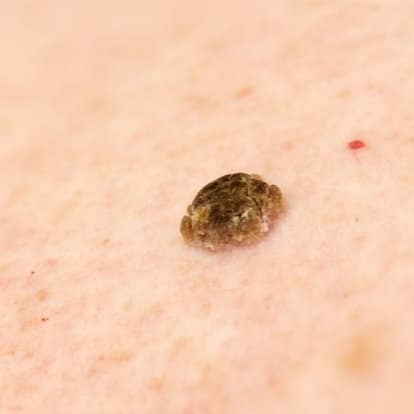OVERVIEW:
Seborrheic keratoses are very common skin growths. They are benign and not worrisome. Seborrheic keratoses tend to develop as you age, with people over 40 more likely to develop these growths. They can occur anywhere on the body except the palms and the soles. They are typically found on the head, neck, chest, or back.
What are the Symptoms of Seborrheic Keratoses?
Common findings include:
- The growths can be white, tan, brown, or black.
- It can vary in number, occurring as a solitary growth (seborrheic keratosis) or multiple growths (seborrheic keratoses).
- Seborrheic keratoses can vary in appearance and texture; they can be flat, scaly, waxy, and even warty in appearance.
- The growths can range in size from very small to very large.
- The growths can be itchy and irritate if they catch on jewelry or clothing.
Though the exact cause of seborrheic keratoses remains unknown, according to WebMD, genetics and pregnancy can play a role in their development. The lesions are not contagious.
Treatment for Seborrheic Keratoses:
Seborrheic keratoses are benign and not problematic, but they can also be confused with other skin growths such as precancers and skin cancers. You should always schedule a visit with a board certified dermatologist if you have any growths or lesions of concern. Any new skin growth or change in an existing skin growth should prompt a visit to your provider. Your dermatologist can also evaluate and remove any symptomatic or bothersome growths.
Usually, a dermatologist can diagnose seborrheic keratoses by looking at your skin. If there is any uncertainty or question about the diagnosis, a skin biopsy can be done.
While there is no way to prevent their occurrence, your dermatologist can remove the seborrheic keratoses if desired. Although the growths are not concerning, seborrheic keratoses can be removed if they are bothersome, irritating, or unsightly to the patient.
Common treatments for seborrheic keratoses include:
- Shave Removal or Shave Biopsy
Your dermatologist can remove the growth by shaving it off with a blade or scraping it off with a surgical instrument called a curette. - Cryotherapy
Liquid nitrogen can be applied to the growth to freeze and destroy the lesion. After treatment, the site usually appears pink and puffy and can even blister. Over the course of a few days to weeks, the growth then turns dark and crusty and peels off. Larger lesions may require more than one treatment. - Electrosurgery
Electrosurgery (electrocautery) uses an electric current to heat and burn away the undesired seborrheic keratoses. The treated lesions become dark and crusty and peel away.







